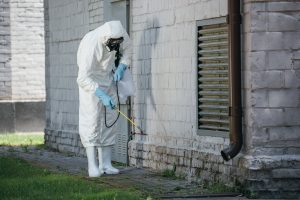
Chlorpyrifos is an organophosphate pesticide sprayed directly on growing crops, sprayed to kill mosquitoes, and sprayed on certain forest trees. In Canada the food crops affected include canola, flax, lentil, corn, strawberry, celery, cucumber, green peppers, pak choi, broccoli, brussels sprouts, cabbage, cauliflower, garlic, potatoes, barley, wheat, oats onions and carrots. The chemical degrades into transformation products including chlorpyrifos oxon, which is considered more toxic.
Chlorpyrifos has neurodevelopment effects on infants in utero and in their early years. As a result, the US Environmental Protection Agency (EPA) and the European Food Safety Authority (EFSA) banned all food used of chlorpyrifos in *. , [confirm]. PMRA did not conduct a proper assessment of chlorpyrifos. PMRA did purport to cancel all uses of it in Canada in December, 2021, but at the same time it is allowing it to be used until the end of 2023. Such “phase-out” uses are allowed pursuant to PMRA’s Policy on Cancellations and Amendments (Cancellation Policy).
Safe Food Matters call on PMRA to cancel all uses of chlorpyrifos immediately, and to cancel the Cancellation Policy. If a pesticide is cancelled because it is harmful, there is no justification for continuing to use it. We have gone to court against PMRA, together with Prevent Cancer Now, on these issues. Ecojustice is our legal counsel.
SAFE FOOD MATTER'S WORK: SUMMARY
SFM provided a notice of objection (NoO) to PMRA’s December 10, 2020, environmental assessment of chlorpyrifos. It is also taking PMRA to Court, along with Prevent Cancer Now, over its policy which allows cancelled pesticides to stay in use for 3 years after cancellation. Ecojustice is counsel on the case
Notice of Objection, environment
PMRA on December, 10, 2020 issued a decision on the environmental assessment of chlorpyrifos (RVD2020-14 Chlorpyrifos and Its Associated End-use Products (Environment)). SFM provided a notice of Objection (NoO) to the decision and submitted it with other groups. The NoO is linked here Notice of Objection: Chlorpyrifos (environment).
The NoO made many points. One of the main points is PMRA said the risks were reduced, not eliminated. Because risks are not eliminated, PMRA cannot justifiably come to the conclusion that “no harm” to the environment will arise from the use of chlorpyrifos. Risks still exist.
When it came to spraying on standing water, PMRA did not conduct an assessment and misunderstood the value proposition. When it came to “fogging”, PMRA did not understand the inhalation risk, or conduct an assessment on animals that would be affected. It created some kind of unplausible explanation that “cryptic habitat” would “intercept” chlorpyrifos and not touch ground. PMRA allowed broadcast spraying in areas of residential structures, even though chlorpyrifos is neurotoxic to children and can persist in and travel in air for long times and distances.
With respect to uses on forests to kill elm bark and pine beetle, it incorrectly misapplied the science on elm bark beetle to the mountain pine beetle. Chlorpyrifos is effective at killing the elm bark beetle when applied to the lower portion of the tree trunk because that is the location where the elm bark beetles locate to overwinter, but this does not happen with pine beetles, so spraying only the base is ineffective.
PMRA was of the view that chlorpyrifos does not meet criteria of a toxic substance, however the European Chemicals Agency is of a different view. It held that the chemical meets the criteria for persistence, bioaccumulation and bioconcentration and applied for chlorpyrifos to be included as a persistent organic pollutant in the Stockholm Convention on Persistent Organic Pollutants.
PMRA did not respond to the Notice of Objection of SFM and the other groups, but instead proposed “that the Notice of Objection be closed” because the uses of chlorpyrifos were being cancelled. SFM did not agree to the proposal. To date, SFM has not received a response to its NoO.
On May 13, 2021, PMRA issued REV2021-02, Update on the Re-evaluation of Chlorpyrifos, in which it indicated it was cancelling and phasing-out all uses of chlorpyrifos. In June PMRA wrote to SFM to propose that the NoO be closed. SFM did not agree to closure of the NoO, and has not received a response to the NoO.
Chlorpyrifos Court Case
On May 13, 2021 PMRA released REV2021-02: Re-evaluation Note: Update on the Re-evaluation of Chlorpyrifos. in which it purported to cancel the registration of chlorpyrifos but allowed it to stay in use in Canada and be “phased out” for 3 more years. PMRA didn’t provide any reasons or impose any conditions.
See this: MEDIA STATEMENT: After Green-lighting Chlorpyrifos in December, #Health Canada Finally Plans to Put Brain-Wasting #Pesticide Out to Pasture (delaying action for years, following rulings in EU, and US Federal Court of Appeals)
SFM and Prevent Cancer Now sued PMRA in federal court on June 14, 2021, court over the Phase-Out Decision, arguing it was unreasonable, and that a cancellation decision should require cancellation now, or in a few months (like in Europe), not in a few years. See: Delay, Delay… by the PMRA.
PMRA conceded in a legal letter that its decision was not reasonable. Being “not reasonable” means PMRA loses.
But then on December 21, 2021, PMRA issued a “do-over” decision, REV2021-04, Cancellation of remaining chlorpyrifos registrations under paragraph 20(1)(a) of the Pest Control Products Act, and this time provided reasons. Why? We think because PMRA finally caught up with the law, written in the Supreme Court of Canada case Vavilov and reinforced by our glyphosate court case win in the Federal Court of Appeal, indicating that the regulator needs to provide good reasons.
So, on January 20, 2022, Prevent Cancer Now and SFM, with Ecojustice as counsel, sued on the “Do-over” decision, claiming it is unreasonable as well. We argue the decision was unreasonable because it was full of contradictions, inconsistencies, and a lack of transparency in the agency’s decision-making process. For more, see: Lawsuit slams lack of transparency in Health Canada’s management of chlorpyrifos.
Both lawsuits have been consolidated now in front of the Federal Court of Canada.
There are 2 problems with PMRA’s approach to chlorpyrifos:
First, they are applying a “default” policy, called Policy on Cancellations and Amendments Following Re-evaluation and Special Review. PMRA relies on this Policy and says that after a product is cancelled, it is allowed a 3-year phase out unless “imminent and serious risks are identified”.
The Pest Control Products Act doesn’t speak to allowing a 3-year phase-out, but instead talks about different options for orderly cancellation such as seizure, recall and disposal. Allowing a 3-year phase-out for a product that has been cancelled does not protect Canadians, which is the main purpose of the Act and PMRA’s main job. Section 4 sets out the primary objective of the Act as: “prevent unacceptable risks to individuals and the environment from the use of pest control products”.
Second, they completely dropped the ball in their assessment of chlorpyrifos. Big time. They simply didn’t assess it when they should have, when they knew that other regulatory agencies in the world were finding problems and banning it. And when the assessments that PMRA scientists did show problems, “official” PMRA ignored them. And ignored other requests and recommendations of its own scientists.
Here are a few examples from the record, explained in the Applicants’ Memorandum of Fact and Law (basically the argument):
- Some scientists at PMRA had pointed out that there were potential unacceptable risks from chlorpyrifos. There were both hazards and exposures of concern. The PMRA ignored this and didn’t let the public know. Ever.
- In addition, PMRA did not conduct any kind of assessment on whether risks were “imminent” or “serious”, yet states in its cancellation decision that Health Canada had determined that “the risks are not imminent and serious during the phase-out period “and that therefore, in accordance with the Cancellation Policy, a 3-year phase-out was allowed.
- The record even shows that some PMRA staff had asked senior managers to NOT include language suggesting that they had evaluated serious or imminent risk, because “we haven’t done the additional work related to human health”. Obviously, this ask was ignored.
- PMRA scientists also repeatedly raised serious unassessed hazards and outdated assessments associated with chlorpyrifos. The last dietary risk assessment was done in 2000 and did not include drinking water. *, despite the fact that *.
- PMRA scientists had found unacceptable drinking water exposure from chlorpyrifos uses. This was never told to the public or mentioned in the decisions.
- PMRA decided in 2008 to put the re-evaluation of human health effects for chlorpyrifos “on hold”, and did so until 2019, even though the US Environmental Protection Agency (EPA) in its assessments from 2008 on had found that serious neurodevelopmental effects in children were expected at lower levels then previously thought. EPA revoke chlorpyrifos uses on food in *.
- Some PMRA scientists recommended the toxicology assessments be updated to align with the EPAs, because PMRA’s was “out of date, against current practices”. This wasn’t done.
- A transformation product of chlorpyrifos is chlorpyrifos oxon, which arises in drinking water due to chlorination. The EPA found chlorpyrifos oxon to be 1000 times more toxic than chlorpyrifos. PMRA did not establish toxicology endpoints for the oxon, but in the decisions claims that the oxon is “low risk”.
In our view, this conduct on behalf of the regulator is completely unacceptable, and shameful. It is clear that PMRA is not performing its job of protecting Canadians and the environment from the harms of pesticides. If it is because of a lack of resources, get the resources. If it is because of lack of will, get the people who have the will. SFM and other non-governmental groups should not have to be the watchdog for our health, when it is PMRA’s job.
REGULATORY / OTHER FILINGS
Federal Court Chlorpyrifos Cases
T-121-22
2022 09 28 – Applicants’ Memorandum of Fact and Law
2022 01 20 – Notice of Application – Safe Food Matters INC et al v. AGC et al (T-121-22)
2022 01 19 – First Affidavit of Dr. Elaine MacDonald
2022 03 07 – Second Affidavit of Dr. Elaine MacDonald
T-956-21
2022 02 10 – Second Amended Notice of Application, Court File No. T-956-21
2021 11 02 – Affidavit of Margaret Sears
2021 11 03 – Affidavit of Mary Lou McDonald
2021 11 17 – Affidavit of Elizabeth Gabel
2021 12 07 – Affidavit of Charlotte Ireland
2022 01 19 – First Affidavit of Dr. Elaine MacDonald
2022 03 07 – Second Affidavit of Dr. Elaine MacDonald
Regulatory Filings
2021 02 08 – Chlorpyrifos Notice of Objection to PMRA
What You Can Do
* Until chlorpyrifos is no longer in use in Canada, eat only organic varieties of foods that may have been sprayed with chlorpyrifos. These include: canola, flax, lentil, corn, strawberry, celery, cucumber, green peppers, pak choi, broccoli, brussels sprouts, cabbage, cauliflower, garlic, potatoes, barley, wheat, oats, onions and carrots.

